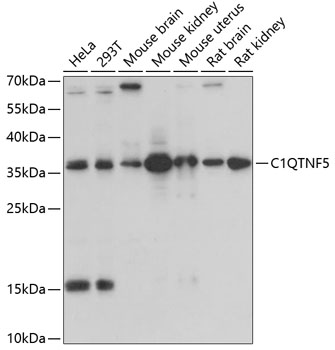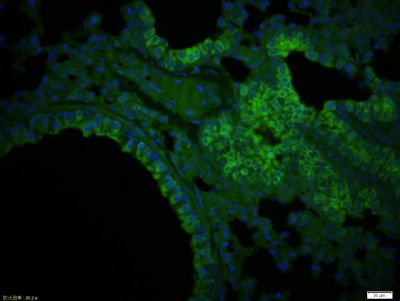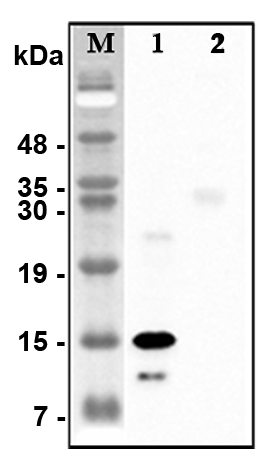
Western blot analysis using anti-CTRP5 (human), pAb (Prod. No. AG-25A-0103) at 1:5000 dilution. 1: Human CTRP5 (tGD) (His-tagged). 2: Human CTRP5 (His-tagged). 3: Human CTRP5 (GD) (His-tagged) (negative control). 4: Human CTRP6 (H
anti-CTRP5 (human), pAb
AG-25A-0103
ApplicationsWestern Blot, ELISA
Product group Antibodies
TargetC1QTNF5
Overview
- SupplierAdipoGen Life Sciences
- Product Nameanti-CTRP5 (human), pAb
- Delivery Days Customer10
- ApplicationsWestern Blot, ELISA
- CertificationResearch Use Only
- ClonalityPolyclonal
- Concentration1 mg/ml
- Gene ID114902
- Target nameC1QTNF5
- Target descriptionC1q and TNF related 5
- Target synonymsCTRP5, MFRP, complement C1q tumor necrosis factor-related protein 5, C1q TNF-alpha-related protein 5, C1q and tumor necrosis factor related protein 5, Membrane frizzled-related protein, myonectin
- HostRabbit
- Protein IDQ9BXJ0
- Protein NameComplement C1q tumor necrosis factor-related protein 5
- Scientific DescriptionCTRP5 (C1qTNF-related protein 5; C1QTNF5) belongs to a highly conserved family of adiponectin paralogs. CTRP5 mediates activation of AMP-activated protein kinase (AMPK) in muscle and liver cells, thereby regulating glucose and lipid metabolism. Serum levels of CTRP5 are significantly higher in obese/diabetic animal models compared to normal controls. Furthermore, CTRP5 may be a putative biomarker for mitochondrial dysfunction. Defects in C1QTNF5 are a cause of late-onset retinal degeneration (LORD). - Polyclonal Antibody. Recognizes the N-terminal half of CTRP5 full-length protein. Detects bands of ~15kDa and ~26kDa by Western blot. Source: Rabbit. Applications: ELISA, WB. Liquid. 0.2microm-filtered solution in PBS, pH 7.4. Contains no preservatives. CTRP5 (C1qTNF-related protein 5; C1QTNF5) belongs to a highly conserved family of adiponectin paralogs. CTRP5 mediates activation of AMP-activated protein kinase (AMPK) in muscle and liver cells, thereby regulating glucose and lipid metabolism. Serum levels of CTRP5 are significantly higher in obese/diabetic animal models compared to normal controls. Furthermore, CTRP5 may be a putative biomarker for mitochondrial dysfunction. Defects in C1QTNF5 are a cause of late-onset retinal degeneration (LORD).
- Storage Instruction-20°C,2°C to 8°C
- UNSPSC12352203









